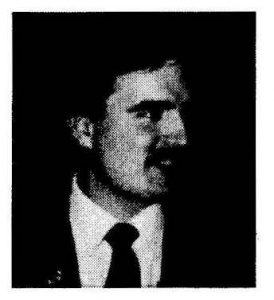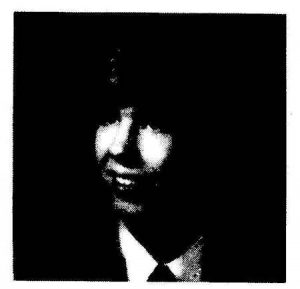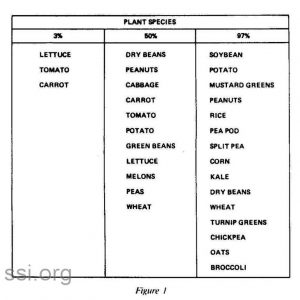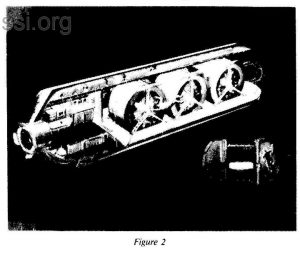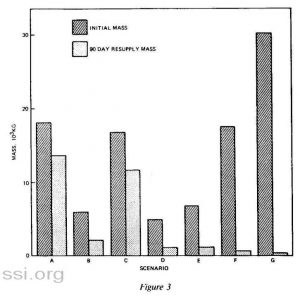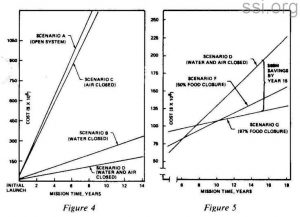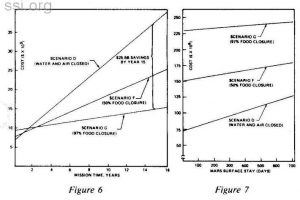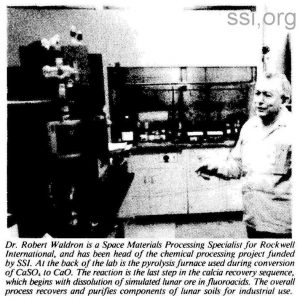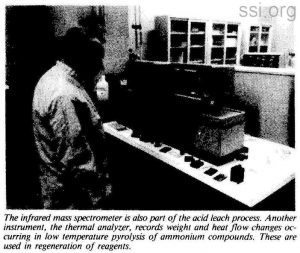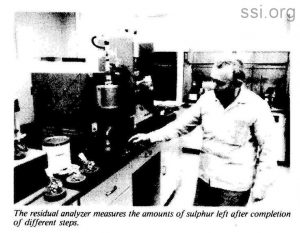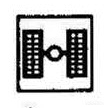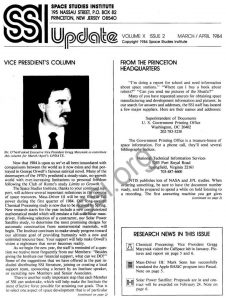
SSI UPDATE
SPACE STUDIES INSTITUTE
195 NASSAU Street, P.O. Box 82
PRINCETON, New Jersey 08540
[[librarian note: This address is here, as it was in the original printed newsletter, for historical reasons. It is no longer the physical address of SSI. For contributions, please see this page]]
VOLUME X ISSUE 2
MARCH/APRIL 1984
copyright 1984 Space Studies Institute
VICE PRESIDENT’S COLUMN
Dr. O’Neill asked Executive Vice President Gregg Maryniak to contribute !his column for March-April’s UPDATE
Now that 1984 is upon us we’ve all been inundated with comparisons between the world as it now exists and that portrayed in George Orwell’s famous satirical novel. Many of the doomsayers of the 1970’s predicted a steady-state, no-growth world with ever-increasing limitations to personal freedom following the Club of Rome’s study limits to Growth.
The Space Studies Institute, thanks to your continued support, will achieve several important milestones in the opening of space resources. Mass-Driver III will be test fired at full power during the first quarter of 1984. Our long-awaited Chemical Processing study is now due to be received by Spring. New research starts for the year include a new computerized mathematical model which will emulate a full-scale lunar massdriver. Following selection of a contractor, our Solar Power Satellite study, to determine the most promising designs for automatic construction from nonterrestrial materials, will begin. The Institute continues to make steady progress toward our ultimate goal of providing humanity with a new and unlimited resource base. Your support will help make Orwell’s vision a nightmare that never becomes reality.
As we begin the new year, the staff is reminded of a question we receive most frequently from our Members: “Besides giving the Institute our financial support, what can we DO?” Some of the suggestions that we have offered in the past included distributing SSI literature, joining or creating a local support team, sponsoring a lecture by an Institute speaker, or recruiting new Members and Senior Associates.
There is another really important step that each Member of SSI can undertake, which will help make the Institute the most effective force possible for attaining our goals. That is to select one aspect of space development that is of particular interest to you, identify the key literature in that area and learn enough about the subject to be able to teach it to someone else. One way to begin this endeavor might be to review some of the general books on space industrialization and space colonies.
For most of us, the most difficult step in the process is locating good information about the availability of books and other materials on space colonization and development. To assist you in the search, SSI will be including a suggested bibliography with every issue of UPDATE for the rest of this year. Each of the books listed in the first general bibliography contains suggestions for further reading.
Another approach might be to read as many of the suggested references as you can conveniently locate. Ifyou adopt this as a new year’s resolution (it’s never too late!), you’ll be amazed at what you’ll learn about space and spaceflight. Just for fun, I’ve put together a brief quiz to help you check what you know now. A review of the books listed in the bibliographies that we will publish this year will enable you to find any answers you don’t know yet.
One of our resolutions for 1984 is to assist our Members in learning as much as possible about our common areas of interest. We will continue to keep you advised of useful books, magazines and other educational resources throughout the year. Join with us in 1984. Let’s become the best informed space interest group on the planet!
Space Quiz
1. What major superpower of its day succumbed to pressure from its bureaucracy to cancel exploration in favor of domestic programs before the voyage of Christopher Columbus?
2. Who were the major advisors to President Kennedy in his decision to promote the Apollo program? What were their respective roles?
3. List at least two features of the European Ariane program that make it competitive with the Space Shuttle.
4. Why does the Shuttle’s Manned Maneuvering Unit use pressurized nitrogen as a propellant instead of a more energetic fuel?
5. Sketch three major Space Shuttle modifications or derivatives currently under study.
6, What are the six classical elements which define an orbit?
7. What change of velocity if required to place an object into Low Earth Orbit (LEO)? Into geostationary orbit?
8. Define the concept of closure in self-replicating systems.
9. What is a relative motion plot?
10. Why is Mass-driver III capable of over three times the acceleration of its predecessors?
FROM THE PRINCETON HEADQUARTERS
“I’m doing a report for school and need information about space stations.” “Where can I buy a book about robots?” “Can you send me pictures of the Shuttle?”
Many of you have requested sources for obtaining space manufacturing and development information and pictures. In our search for answers and addresses, the SSI staff has located a few major suppliers. Here are their names and addresses:
Superintendent of Documents
U. S. Government Printing Office
Washington, DC 20402
xxx-xxx-xxxx
The Government Printing Office is a treasure-house of space information. For a phone call, they’ll send several bibliography indices.
National Technical Information Services
5285 Port Royal Road
Springfield, Virginia 22161
xxx-xxx-xxxx
NTIS publishes lots of NASA and JPL studies. When ordering something, be sure to have the document number ready, and be prepared to spend a while on hold listening to a recording. The first answering machine you get gives instructions and other numbers for specific requests.
Audio Visual Branch
Public Information Division
Code LFD-10
NASA
400 Maryland Avenue S W
Washington, DC 20546
xxx-xxx-xxxx
Slides, pictures, information on every American space mission since the Explorer satellite got it all started, plus weather satellite information.
For our Members and Associates in southern California, SSI Board of Trustees member James Burke has offered to present lectures about SSI and our research to interested groups in that area. LECTURE REQUESTS MUST BE SENT TO ERIN MEDLICOTT AT THE SSI PRINCETON OFFICE.
Thanks go to all of our new Members who have completed and returned their survey forms. Your ideas and suggestions give us clues to better UPDATE, look for new sources of research funding, and help us keep in touch with you.
We’re still looking for contributions for the bibliographies that will be included with the next several issues of UPDATE. The January/February issue this year gives the guidelines for your suggestions.
COALITION ENDORSES SPACE STATION
In early January, Members and Senior Associates of SSI received a notice asking for letters to Washington endorsing a moon base and space station. This mailing was a last minute addition to one already being sent, and the bulk mail channels got most of the letters to Members on time. Many of you were able to respond, and from Mr. Reagan’s speech later that month, it seems that we were heard.
The Space Studies Institute joined with fourteen other member organizations in the National Coordinating Committee for Space, representing 100,000 members across the country, in preparing this statement:
“A space station is not a goal in itself, but an essential first step in regaining the United States’ preeminence in space exploration and development. Funding for the station should be in addition to – not in place of – NASA’s regular budget. There must not be a repeat of the 70’s when the development of the Space Shuttle cut heavily into all our other space programs.
“A space station will enable the United States to compete more effectively with the Soviet Union and other nations that are so actively engaged in the exploration and industrialization of outer space. It will also enable our corporations and entrepreneurs to compete in the commercial development of this vital new frontier. In addition, it will provide a less expensive means for our continued, preeminent exploration of the solar system on behalf of all mankind.
“A space station will establish the necessary launch base for our early return to the Moon and for the exploration of other planetary bodies. Such exploration will enable us to procure essential resources for continued development on Earth and in space.
“We commend the President for committing the United States to the establishment of a space station and the long range development of outer space. We encourage the adoption of this program by the Congress.”
GUEST COLUMN
Senior Associate Tim Vinopal manages the pre-proposal efforts on reuseable orbital transfer vehicles for the Boeing Corporation. In addition, he has done structural design, analysis and systems configuration design for the Orbital Maneuvering Vehicle (OMV) and several other space station related projects. This guest column reflects research presented in a paper at the May 1983 Space Manufacturing Conference.
When to Use Closed-Cycle Life Support Systems?
Since the early 60’s the Boeing Company has been studying various types of life support systems and their applicability on Earth and in space. There are three basic methods used to supply a spacecraft crew with necesary water, air, waste, management and food. These methods are:
(1) storing all of the mission consumables onboard before launch, and storing all of the waste products as they are generated, (2) periodically resupplying the consumables via transportation vehicle and returning the waste products, or (3) supplying all essential materials by recycling waste products back into reuseable materials. The first two methods are referred to as resupply or “open” systems, while the last method is known as regenerative, recycle, or a “closed” system.
—————————–
“The Boeing study attempted to determine where completely closing the life support system can make economic sense…”
—————————–
As an overall life support system is designed for a particular mission, several “closure” levels are examined to determine which consumable will be recycled and which will be left “open loop.” Depending on the mission, the optimum support system could range from completely open, only recycling air and/or water, or completely closed (which involves growing food on board). During a recent Boeing study for Ames Research Center, seven distinct closure scenarios were investigated in order to determine for which future space missions each closure scenario was best suited. Scenario A was complete resupply, B recycled water only, C recycled air only, D closed both air and water loops, E additionally grew about 3% of the food, F grew 50% of the food and recycled all of the other wastes and consumables, and G grew or recycled everything except for selected vitamins and condiments (3% of the diet). For the food growing systems, a vegetarian diet was assumed, as shown in figure 1, which consisted exclusively of higher order plants.
Each of these closure scenarios was then examined to determine the design implications for the mission spacecraft. Life support subsystem characteristics such as required power, volume and mass were determined in order to provide a means of comparison among scenarios. Eventually, these three characteristics were reduced to one: mass to be transported from the Earth’s surface to the mission location. The mass corresponding to volume and power requirements will vary with each mission because the volume radiation shielding and chosen power system will vary with mission location.
The Boeing study attempted to determine where completely closing the life support system can make economic sense, and furthermore what the scale of the corresponding cost savings appear to be. When cost savings can be shown to approach or exceed system developmental costs, only then is it likely that these completely closed systems will be developed.
The largest cost differential between closure scenarios will be the transportation costs incurred in resupplying the nonrecycled essentials (food, water, air) and returning wastes, or in delivering the heavy recycling systems initially. The study examined a variety of sizes and locations of potential future (1990-2050) manned missions in order to determine at which point the different recycling scenarios begin to make economic sense.
After studying NASA long-range planning documents and other technical literature we selected six “realistic” manned missions spread out over the next seventy years. The attempt was not to pick the six manned missions most likely to occur in the next seventy years, but rather to bracket the problems of mission size, location and operational era. As discussed previously, it is just these characteristics which will determine power system mass and volume (radiation shielding) mass. The following diverse missions chosen include four in the Earth/Moon system, and two further out in the solar system:
1. Low Earth Orbit (LEO) space station (4-12 personnel) in low (30°) inclination to be launched in 1990. This operations center will not require extra radiation shielding, as it is below the Van Allen Belts, however, it will have a heavy power system because of a large battery requirement (one-third of its ninety minute orbit is in the Earth’s shadow). This space base is directly accessible by the present Shuttle vehicle from Cape Canaveral.
2. LEO scientific station (4 personnel) in high (98°) inclination which is operational in 1995. No additional radiation sheilding is necessary, and the sun synchronous orbit eliminates the need for battery storage. This station is reached using an off-loaded Shuttle from a Vandenberg Air Force Base launch, greatly increasing the cost per pound.
3. Military station (1995 era) in 6xGEO circular orbit will support 4 to 24 personnel with infrequent resupply. The high orbit location ensures continuous sunlight but high radiation levels, which causes high shielding weights and greater solar array degradation. The station is reached using a Shuttle and an Orbital Transfer Vehicle (OTV).
4. Lunar Base will support 12 to 48 personnel involved in mining and transporting lunar soil for space-based construction efforts. This facility (operational in 2010) uses a nuclear reactor for power production and lunar soil for habitat and shielding. A Lunar Transer Vehicle (LTV) is used in concert with a Shuttle and OTV for transportation.
5. Asteroid Base for large scale (5000 personnel) asteroid mining beginning in 2050. A continuously sunlit solar array is used for power production and asterodial materials are used for radiation shielding. Economies of scale and projecting technology seventy years in the future combined to provide a large scale, inexpensive, albeit complex transportation scenario. This mission involves three space bases (LEO, GEO, and Asteroid) as well as several types of advanced launch vehicles and rockets. The most advanced transportation component is a fusion propulsion system used to inexpensively transfer cargo and personnel from GEO to the asteroids.
6. Mars Surface Exploration is a long duration (1000 days) “sortie” projected for 2010 and chosen to determine the effect of non-permanent missions on life support system selection. The mission uses a small reactor for the surface part of the mission, and a solar array for the Earth-to-Mars transit portion (200-250 days each way). The unique transportation system will be assembled at a LEO base after the components are lifted by a Shuttle vehicle.
Each of these diverse missions were analyzed to determine the particular life support system (LSS) weights and corresponding transportation costs. For all missions except for the asteroidal mission (where sheer size required special design) a standard four-person LSS module was designed for each closure scenario. An example four-person food-growing module for scenario F is shown in figure 2.
These modules contain the food-growing subsystems, which also recycle air, water and waste products, or physiochemical systems, such as vapor compression distillation for water recycling, as well as the power system and all other LSS support components. Grouping these systems in a separate module which can be used for most missions provides straightforward weights accountability.
Some results of this LSS study arc presented in figures 3 through 7. Figure 3 compares LEO station LSS initial mass and resupply mass for all seven closure scenarios. It is clear that closing the food loop greatly increases initial system mass, while lowering the resupply mass. At some point the total transportation mass will be lower than for less closed systems.
Figures 4 and 5 project the data presented in the previous illustration for several years of mission operation in order to find the break-even points for each scenario. It becomes apparent that closing both the air and water loops is immediately most effective. In fact, for the first six years of station operation scenario D incurs less transportation costs than any other scenario. Between six and ten years, scenario F has the lowest costs, and if station life is greater than ten years, scenario G (fully closed) has less total transportation costs. After fifteen years of station operation fully closing the life support systems will save approximately 68 million dollars.
These trends continue for the other LEO and lunar missions. In the 6xGEO mission the break-even points occur later because of the large amount of radiation shielding, as the plant-growing scenarios require large volumes which need to be shielded. Even with this penalty 50% closure (scenario F) break-even occurs in year ten, and fully closed (scenario G) break-even in year seventeen.
Figure 6 shows the asteroid mission results, and illustrates the advantage of using asteroidal materials for shielding, and advanced transportation technology. Scenario G breaks even at the time of the first resupply cycle. By year fifteen, the savings generated by scenario G (bver scenario D) is greater than the transportation cost of the total life support system!
The Mars mission costs, shown in figure 7, clearly demonstrate that this mission is not suitable for food growth. The optimization point for a 50% closure is calculated to be for a surface stay of 1948 days (five years), and for full closure the stay would be 3357 days (nine years). These extended surface stays are outside the scope of a sortie mission.
The results of our Boeing work indicate that small missions within the Earth/Moon system could use completely closed life support systems, if the mission stay times are long enough. Most missions outside of the Earth/Moon system will probably require regenerative life support systems, with the exception of non-permanent sorties.
Good news! Mark Senn has successfully translated the Apple BASIC MD-Ill program to Pascal on the Purdue VAX. he is now in the process of trying some runs with real parameters and sending the results back to me for review. There is still much optimization necessary to take advantage of the features of Pascal and the speed of the VAX but we’re now headed in that direction. His first reports are that it does run fast, but we’ll need some more careful comparisons before we know how much faster than the Apple. I’ll give you the results in the next newsletter.
R. D. Waldron
One of the key elements in cost effective space industrialization and expansion of overall activity in near and far space operations is the ability to use nonterrestrial materials such as lunar or asteroidal soil or rocks for substantial portions of the mass requirements for structures, equipment and expendables needed in space. The utility of such easily accessible material will in large measure depend on the ability to produce a diverse range of semi-refined and refined industrial feedstocks capable of supplying a major fraction of the input requirements for a broad spectrum of manufacturing and fabrication operations.
Under a grant from the Space Studies Institute, a research and development project for verification of a HF acid leach process has been conducted jointly by Rockwell International and the California Space Institute. The project is nearly complete, and a final report will be ready this Spring.
SSI’s Solar Power Satellite project is underway. Several universities and organizations have responded with proposals, and the committee is evaluating them. The contract award will be made on February 24. Look for more details in the next issue of UPDATE.
LECTURES
Dr. O’Neill’s lecture schedule for Spring 1984 is as follows. Asterisk(*) denotes lecture closed to the public.)
*March 29: Concrete Reinforcing Steel Institute, Palm Beach, Florida
*April 2: IBM-Belgium, Madrid, Spain.
April 10: The Lawrenceville School, Lawrenceville, New Jersey.
——————————-
I wish to support the research and education programs of SSI for one year as a:
[ ] Sponsor ($200-$500)
[ ] Donor ($50)
[ ] Sustaining Member ($15)
[ ] Patron ($100)
[ ] Contributor ($25)
[ ] This is a renewal.
[ ] New address.
[ ] YES, I understand the importance of expanding SSI’s Membership base. The lnstitute’s work is critical and you need the support of more concerned people to keep at it.
[ ] I’ve done my part. Here are checks or money orders from ___ new SSI Members, all of whom have joined with at least a $15.00 donation. __
[ ] Here’s my special gift of $____ for the Solar Power Satellite design study.
[ ] YES! I would like to give EXTRA support for Mass-Driver III. Here’s my check for $___
[ ] I want to be one of the First Thousand. Send me Senior Associate information today.
Name:
Address:
City, State, ZIP:
Send with check or money order to SSI, 195 Nassau Street Princeton, New Jersey 08540
[[librarian note: This address is here, as it was in the original printed newsletter, for historical reasons. It is no longer the physical address of SSI. For contributions, please see this page]]
(Canadian Members not using bank card, please remit in US funds by postal money order /bank draft)
– ALL DONATIONS ARE TAX DEDUCTIBLE
©space studies institute

